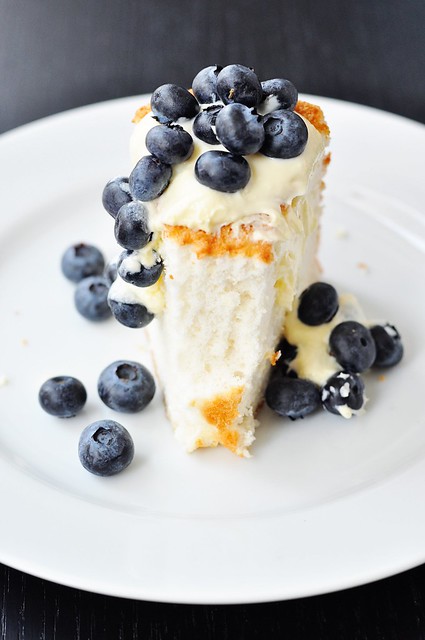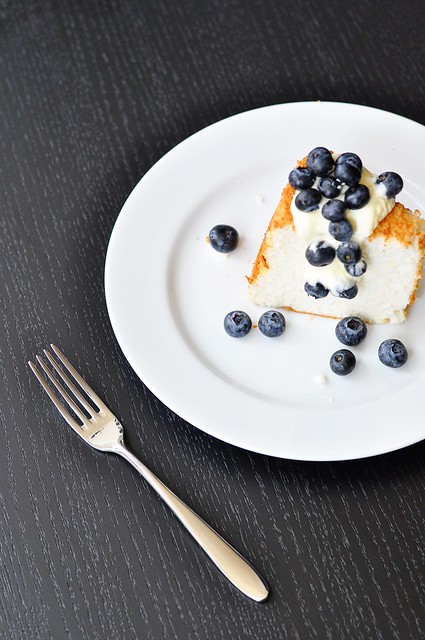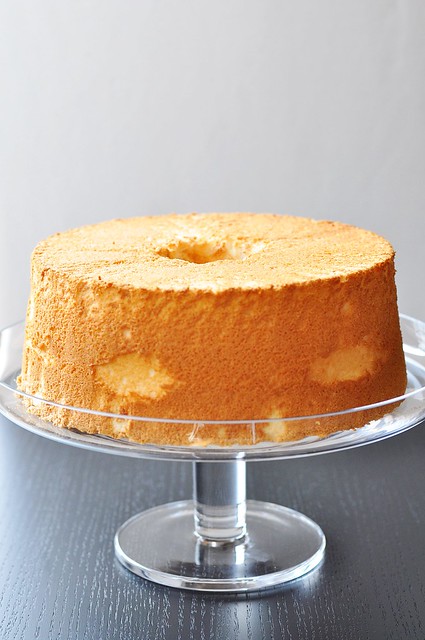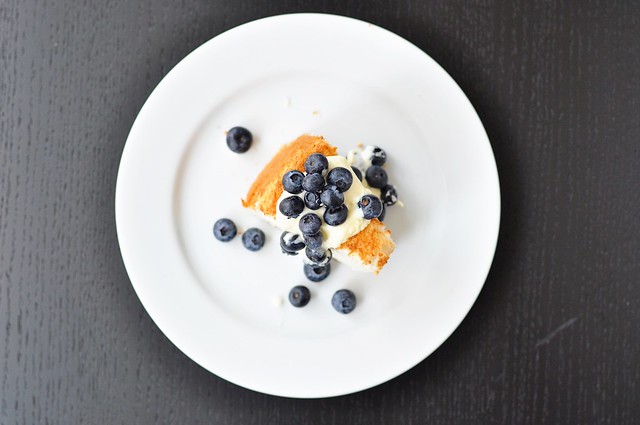Angel Food Cake
I’m not sure what exactly possessed me to set to work on a recipe for Angel Food Cake. Maybe its light, airiness seemed right for summer? Maybe…. Okay, I’d come up with other “maybe”s, but truly I have no idea. Once I got it in my head, however, it stuck. And I’m glad it did.
As a starting point for the recipe, I turned to none other than Alton Brown. The guy knows his stuff, and the things I’ve learned from watching and reading AB inform everything I bake today. I may have said this here before, but this book taught me nearly everything I know. I firmly believe that understanding baking the way he explains it (visually, scientifically) is the reason I’ve had such success in creating gluten-free recipes.
So starting with one of his recipes was, well, a recipe for success. (Feel free to groan at that one.)
The cake came out beautifully on the first try—though I did tweak a few things to make it even better the second time around. And having made it twice in one week, I can tell you that Angel Food Cake takes a little bit of patience…and upper body strength. Don’t be mistaken, it’s not a difficult thing to put together. It’s just that it takes some time to beat a dozen egg whites* just shy of stiff, and that in combination with the very, very gradual folding in of the flours may have your shoulders protesting. But, having made it twice, I can also tell you that it’s totally worth the effort.

This cake is a delicate, spongy thing that practically melts away on your tongue. It tears apart in fluffy chunks, moist and cloud-like. Chris and I like to cut its characteristic sweetness with a bit of tangy crème fraiche or unsweetened whipped cream, but it’s perfectly good on its own.
That said, a tumble of ripe berries is always welcome.
Angel Food Cake
Adapted from Alton Brown
Angel Food Cake is a blank canvas. You can keep it simple by making it as written with vanilla extract or feel free to experiment with other flavorings. Almond extract would be great or you could add a teaspoon of citrus zest for a fresh twist.
1/3 cup / 1.4 oz millet flour
1/3 cup / 1.8 oz brown rice flour
1/3 cup / 1.4 oz tapioca flour
1/2 teaspoon xanthan gum
1/2 teaspoon Kosher salt
1 1/2 cups sugar, divided
12 large egg whites*
1/4 cup / 2 oz warm water
1 teaspoon vanilla extract
1 1/2 teaspoons cream of tartar
Preheat the oven to 350 degrees.
Add the millet, brown rice and tapioca flours, the xanthan gum, salt, and 3/4 cup of the sugar to the bowl of a food processor. Pulse to combine and then let the processor run for about a minute to aerate the ingredients. (Alternately, whisk these ingredients together in a medium bowl, working to aerate them as much as possible.)
Place the egg whites, water, vanilla extract, and cream of tartar in a large bowl. Using an electric hand mixer, beat on low speed until the mixture is very frothy. Once frothy, increase the speed to medium and slowly add in the remaining 3/4 cup of sugar. Beat until medium peaks form (a peak will hold, but not stiffly). Sift or sprinkle a small amount of the flour mixture over the top of the beaten whites and fold to combine. Continue until all the flour has been incorporated. It will take several additions.
Carefully pour the batter into an ungreased tube pan with removable bottom. Bake for 45 minutes. A toothpick inserted in the cake will come out clean when done.
Invert the pan over a cooling rack and allow the cake to cool upside-down for at least an hour. Run a long, thin knife in between the wall of the pan and the cake, and also around the tube, to begin to release the cake from the pan. Pull out the tube/bottom insert with the cake attached. Run the knife between the cake and the bottom of the pan to release it the rest of the way. Carefully invert over a cake plate. The cake will fall away from the pan.
To slice, use a sawing motion instead of downward pressure; Angel Food is delicate and this will keep it from smooshing down when being cut. Serve unadorned or with creme fraiche or unsweetned whipped cream and berries.
*If you’re worried about what to do with all those egg yolks, this site has a lot of good links to recipes requiring yolks only. I’ll also soon be showing you a recipe requiring 4 yolks and yet another requiring 6. Update: Also, you could use up 4 yolks in this Boston cream pie and another 6 in this 7-yolk pasta (the 7th yolk comes from a whole egg)! You can save your yolks in an airtight container in the fridge for a couple days or you can freeze them for up to a year (instructions for freezing here).






18 comments:
Beautiful recipe! I can almost taste it now
The pictures are so inviting! Delish.
I made this last weekend. It was A…MAZ…ING!!!!! I have so missed angel food cake and now I’m a happy girl once again! Thank you for sharing this recipe! I will be making it again this week to enjoy with some fresh peach topping.
Is there a good substitute for the millet flour?
Andrea, you could try substituting sorghum flour.
I am baking this at elevation (over 5000 feet) for a friend’s birthday (she is GF and angel food cake is her fav). Do you know if anything should be altered? Thank you!
Amy, I know this response is a bit delayed–apologies. Unfortunately I don’t know much about adjustments for baking at elevation. Google would probably be a good help there.
Do the three flours do something special or would a good all purpose gluten free flour work as well? I generally use King Arthurs Gluten Free flour in recipes.
I tried making this with the King Arthurs Gluten Free flour and some Tapiocca starch that I had available and the cake came out perfectly. Amazing Angel Food cake! I’ve made it twice so far and non-Celiac friends devour it with me. Thank you for this recipe :0)
Thanks for the update, Ann! I’m glad you went ahead and tried with the AP mix. I choose the specific flours that I do for each recipe based on what I think will give that particular baked good the best texture and flavor. That said, most (if not all) of my recipes should be able to take an AP blend as direct substitute for the recommended flours. So glad that everyone loved the cake!
Just made this for a Mother’s Day gathering and served it with lemon mousse and strawberries. It was amazing! Thanks for the recipe!!
I am new to baking by weight. I bought an OXO scale and the ounces weight is by 1/8ths. I can’t seem to get my head wrapped around what 1.4 oz would be and 1.8 oz using my scale?
Also, is tapioca starch and tapioca flour one in the same?
Thanks!
Laurel, you’ll have to do a little math. 1/8 in decimals is 0.125 (literally 1 divided by 8). So, 1.4 would be roughly 1 3/8 and 1.8 would be about 1 6/8. It won’t be totally precise, but you should be able to get close enough.
And yes, tapioca starch and tapioca flour are the same! The only instance I’m aware of where there is a difference is potato starch and potato flour.
Are the ingredients measured by either volume (i.e. 1/3 cup) OR weight (the ounces)? or do you need to measure both?
I don’t have a tube cake tin. Would a normal spring form cake tin work or wouldn’t it cook in the middle? The recipe also states to not grease the pan. Do you use a non-stick cake tin?
Samantha – I can’t say for sure whether a spring form cake tin would work. The reason you don’t grease the pan, though, is because angel food cake sort of climbs the pan as it bakes and it needs to be able to stick to the sides a bit to create that structure, otherwise it will slide back down the pan and deflate once it cools. You’ll actually find that tube pans made specifically for angel food cake often have a somewhat rough finish because of this.
Ann – The ingredients can either be measured volumetrically OR by weight. Both metrics are provided so that people can measure their ingredients however they prefer.
I am so excited to find this recipe on this site. I have craved it for years. I’ve been a baker for over 39 yrs and owned bakeries too. THEN, poof.. I have Celiacs and it blew me away. Now I have to learn new ways of baking for me. Thank You so much